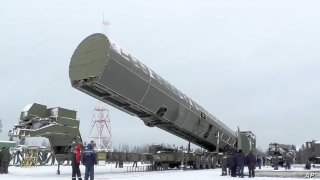What Does This Mean: Russia Says RS-28 Sarmat ICBM Has "Unlimited Range"
This nuclear missile deserves a closer look.
Key point: It is much too early to conclude that Sarmat development is back on track
Of the six strategic weapons unveiled by Russian President Vladimir Putin at his oft-cited 2018 annual state-of-the-nation address, “RS-28 Sarmat” is among the most consequential.
Dubbed “Satan 2” in NATO reporting, Putin described Sarmat as a “heavy,” uninterceptable ICBM with “practically unlimited range.”
Sarmat has since been hailed as the imminent future of Russian counterforce capability; a 200-ton, mach 10, liquid-fuelled weapon that’s orders of magnitude more powerful than the four-decades-old Soviet RS-36M missile it is replacing.
But updates have been scant over the remainder of 2018, nor has the Kremlin offered a concrete development timeline. So, where is Sarmat? Potentially right around the corner, according to a recent series of Kremlin statements.
At a Kremlin military ceremony held last week, Putin gave a speech on the need to “meld Russian military tradition with the latest, cutting-edge knowledge, technology, and ability to effectively apply them…” Recounting the recent examples in this vein, Putin mentioned that “Kinzhal” hypersonic missiles and the “Peresvet” laser system are already being delivered to the Russian armed forces before briefly turning to Sarmat, which he announced is “successfully undergoing final testing.”
“Successfully undergoing final testing” is a carefully worded statement if there ever was one. This can suggest any number of timelines, depending on the scale of the “final testing” and how far along Sarmat is in that process; it can put Sarmat’s delivery date anywhere from right-around-the-corner to several years away. Skepticism would not be wholly unfounded, given Sarmat’s prolific history of delays. Ejection tests originally slated for 2015 were pushed back to 2016, and then again to the end of 2017; the 2017 tests revealed serious technical flaws with the ejection mechanism, further complicating Sarmat development. The US State Department, for their part, made light of the situation with the creation of a new SARMAT, or “senior advisor for Russian malign activities and trends,” post.
Sarmat’s new serial production deadline is 2021, according to a TASS report citing a defense insider source. Sarmat’s developmental track record casts this timeline in a justifiably dubious light, though more recent reports have instilled Russian commentators and observers with a newfound cause for optimism. Several months ago, Chairman of the Scientific and Technical Council at Roscosmos Yuri Koptev suggested that Russian engineers had finally managed to put Sarmat’s technical troubles behind them: "A very serious stage was held last year. This involved pop-up tests, which confirmed the correctness of all the basic technical solutions.” The nature of these “technical solutions” is unknown, but they seem compelling enough to Roscosmos CEO Dmitry Ragozin, who personally reassured Putin in early February that the testing is proceeding as planned and will wrap up by 2020.
It is much too early to conclude that Sarmat development is back on track; the results of its upcoming flight test-- to be held at the East Siberian Plesetsk Space Center in the second quarter of 2019-- should prove a more decisive indicator of that. Still, the fact that such high-level Roscosmos executives are willing to put their name behind Sarmat’s timely delivery suggests a newfound degree of confidence in the project.
Whether or not it will be borne out, only time will tell.
Mark Episkopos is a frequent contributor to The National Interest and serves as research assistant at the Center for the National Interest. Mark is also a PhD student in History at American University. This article first appeared last spring.
Image: Creative Commons.

